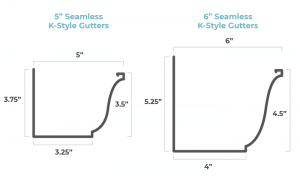Introduction
So you’re in the process of installing new gutters for your home or replacing your existing ones, but you’re not sure whether to go with 5-inch or 6-inch? No worries! We’re here to provide a comprehensive guide to help you make an informed decision that suits your home’s unique needs.
Understanding Gutter Basics
Before delving into the specifics, it’s vitally important to recognize the significance of gutters in protecting your home from water damage. Gutters channel rainwater away from your roof, preventing potential issues such as mold, mildew, and structural damage. While seamless gutter systems offer numerous advantages, the size of the gutters plays a pivotal role in their effectiveness. Let’s review several factors that will aid you in your decision.
Factors To Consider When Making Your Choice
Water Capacity:
The primary distinction between 5-inch and 6-inch gutters lies in their width. But in this case the distinction is an important one as 6-inch gutters can hold approximately 50% more water than their 5-inch counterparts. This is a critical factor, especially in areas with heavy rainfall or frequent storms.  The increased water capacity of 6-inch gutters can prevent overflow, protecting your home’s foundation and landscaping from potential water damage. If your home situation requires gutters with higher water capacity, you may want to consider the 6-inch option. Conversely, 5-inch gutters will be adequate if higher water capacity is not a concern.
The increased water capacity of 6-inch gutters can prevent overflow, protecting your home’s foundation and landscaping from potential water damage. If your home situation requires gutters with higher water capacity, you may want to consider the 6-inch option. Conversely, 5-inch gutters will be adequate if higher water capacity is not a concern.
Roof Planes:
The square footage of your roof’s plane is a key determinant in choosing the right gutter size. A larger roof area naturally requires a gutter system capable of handling more water. For roofs between 600-800 square feet, 5-inch gutters should suffice, while larger roof areas of 1,400+ square feet will certainly benefit from the enhanced capacity of 6-inch gutters.
Roof’s Pitch:
The pitch, or steepness, of your roof is another crucial factor. Higher pitches result in faster water flow which necessitates appropriately sized gutters to manage the increased speed. Even a smaller roof area may benefit from 6-inch gutters if the pitch is steep.
Rainfall in Your Area:
Since differences in size determine higher or lower water capacity, the local climate also plays a pivotal role in your gutter size decision. If you reside in an area that typically experiences high quantities of rainfall, the larger capacity of 6-inch gutters will prove to be advantageous. However, if you reside in an area with a drier climate, 5-inch gutters may be sufficient.
Downspouts:

Also of note would be the size of your downspouts. Typically 3×4 inch downspouts will be used with 5-inch gutters, and 3×4 inch downspouts with pair with 6-inch gutters.
While a larger gutter can hold more water, the larger downspout will allow for a larger volume of rainwater to flow much quicker than the smaller downspout, and can help prevent overflowing during torrential downpours.
Style and Aesthetics:
Aesthetics matter, too. Consider the size of your fascia boards – wider fascia may require larger gutters for a proportional look.
Cost Considerations:
While 6-inch gutters generally come with a higher price tag (about 50 cents to a dollar more per foot on average), the benefits they offer in terms of water capacity and reduced maintenance can outweigh the initial cost. It’s crucial to assess your budget against the long-term advantages of larger gutters. If the previous factors indicate a need for larger gutters, the higher price may prove to be the best option for you in the long run. However, if your roof plane is smaller and you live in an area with lower levels of rainfall, 5-inch gutters may be well suited for the job.
Gutter Maintenance
Before we conclude, it’s critical to understand the importance of regular gutter maintenance, irrespective of size. While gutters are an effective means of channeling water away from your home’s exterior and foundation, they will eventually collect debris such as leaves and sticks. Neglecting regular maintenance can lead to clogs, leaks, and potential structural damage. We recommend cleaning your gutters twice a year to ensure they function effectively in protecting your home. Once again, the size of your gutters does make a difference as the 6-inch gutters are less difficult to clean, and also allow small leaves and pine needles to be easily washed down the larger downpouts.
Conclusion
In the debate between 5-inch and 6-inch gutters, the right choice depends on a myriad of factors unique to your home. Assessing the size and steepness of your roof, the local climate, aesthetics, and your budget can guide you toward a decision that ensures optimal water management and protection against potential damage. Whether you opt for the sleek subtlety of 5-inch gutters or the robust capacity of 6-inch gutters, maintaining them regularly is the key to a healthy and protected home.
